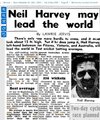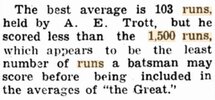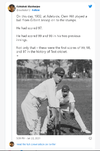Old Mate Fruitcake hit a ton on Steve Waugh's debut, might be what you're thinking of.Yeah I knew he played alongside Warney early I have a feeling he even hit a century in warne’s debut test or certainly in that series at least. His problem was his batting was better than his bowling
Navigation
Install the app
How to install the app on iOS
Follow along with the video below to see how to install our site as a web app on your home screen.
Note: This feature may not be available in some browsers.
More options
-
Mobile App Discontinued
Due to a number of factors, support for the current BigFooty mobile app has been discontinued. Your BigFooty login will no longer work on the Tapatalk or the BigFooty App - which is based on Tapatalk.
Apologies for any inconvenience. We will try to find a replacement.
You are using an out of date browser. It may not display this or other websites correctly.
You should upgrade or use an alternative browser.
You should upgrade or use an alternative browser.
Trivia time!
- Thread starter The Speaker
- Start date
- Tagged users None
🥰 Love BigFooty? Join now for free.
- May 5, 2016
- 52,431
- 59,411
- AFL Club
- Geelong
Old Mate Fruitcake hit a ton on Steve Waugh's debut, might be what you're thinking of.
Nah it was the Sydney test against England 12 months before Warne’s debut
This is a question I would like to know the answer to. In terms of player numbers, it is known that Shane Warne was player 350 to debut for Australia at Test level. In relation to his time at the Rajasthan Royals in the IPL, Warne played in Rajasthan's first ever game in 2008. Rajasthan batted first and Warne came in to bat at number 9. So, would Warne's number be number 9 or, being the team captain, would that automatically grant him number 1?
eth-dog
Tier 1 WW Player
Typically when you captain a new club/franchise first XI you get 1.This is a question I would like to know the answer to. In terms of player numbers, it is known that Shane Warne was player 350 to debut for Australia at Test level. In relation to his time at the Rajasthan Royals in the IPL, Warne played in Rajasthan's first ever game in 2008. Rajasthan batted first and Warne came in to bat at number 9. So, would Warne's number be number 9 or, being the team captain, would that automatically grant him number 1?
Log in to remove this Banner Ad
Baggy greens are given in alphabetical order, so Bannerman is 1, then Blackham, Cooper and the Gregorys. (Except for the Slater/Julian kerfuffle, of course.)This is a question I would like to know the answer to. In terms of player numbers, it is known that Shane Warne was player 350 to debut for Australia at Test level. In relation to his time at the Rajasthan Royals in the IPL, Warne played in Rajasthan's first ever game in 2008. Rajasthan batted first and Warne came in to bat at number 9. So, would Warne's number be number 9 or, being the team captain, would that automatically grant him number 1?
North Melbourne gives our first captain the honour of being Shinboner 1, and then alphabetical order after that
Guess it depends on whatever the Royals owners wanted to do.
Who was the first Test cricketer born after the advent of Test cricket?
I’ll go Warwick Armstrong
- Sep 21, 2004
- 44,169
- 35,593
- AFL Club
- West Coast
- Other Teams
- Norwood & Liverpool.
BoonieWho was the first Test cricketer born after the advent of Test cricket?
On SM-S908E using BigFooty.com mobile app
Who was the first Test cricketer born after the advent of Test cricket?
Who is the answer to this question?
Rabish Binney
Left out overnight
Here's a question I don't know the answer to, but am hoping someone does.
When did the "minimum 20 tests or 20 innings" qualifier get attached to the list of highest batting averages?
It's purely arbitrary, of course, yet is treated as gospel, and we can debate that til the cows come home.
But my question is when? Is it post-Andy Ganteaume, so Bradman still got to be number 1? Sid Barnes batted 19 times, so is excluded, which meant upon his retirement, the next 3 best on the list were all English - Sutcliffe, Paynter and Hobbs. Was that it?
Just curious, that's all.
When did the "minimum 20 tests or 20 innings" qualifier get attached to the list of highest batting averages?
It's purely arbitrary, of course, yet is treated as gospel, and we can debate that til the cows come home.
But my question is when? Is it post-Andy Ganteaume, so Bradman still got to be number 1? Sid Barnes batted 19 times, so is excluded, which meant upon his retirement, the next 3 best on the list were all English - Sutcliffe, Paynter and Hobbs. Was that it?
Just curious, that's all.
Teen Wolf
Brownlow Medallist
- Jul 5, 2011
- 10,690
- 11,430
- AFL Club
- North Melbourne
- Other Teams
- Afghanistan women's cricket team
Not sure when 20 innings was adopted, but it used to be 1500 runs.Here's a question I don't know the answer to, but am hoping someone does.
When did the "minimum 20 tests or 20 innings" qualifier get attached to the list of highest batting averages?
It's purely arbitrary, of course, yet is treated as gospel, and we can debate that til the cows come home.
But my question is when? Is it post-Andy Ganteaume, so Bradman still got to be number 1? Sid Barnes batted 19 times, so is excluded, which meant upon his retirement, the next 3 best on the list were all English - Sutcliffe, Paynter and Hobbs. Was that it?
Just curious, that's all.
16 May 1953 - Neil Harvey may lead the world - Trove
Key parts in this article: "Of the [batsmen] who have scored more than 1,500 runs in Test matches..." and "In the 1953 edition of Wisden's Cricketers' Almanack, just received from London, are listed the 45 batsmen who have made more than 1,500 runs in Tests..."

To address the Andy Ganteaume/Sid Barnes question, we must go back further. Before Ganteaume's only match, and when Barnes only had 128 career runs to his name:
28 Nov 1946 - Test Match Figures - Trove

Last edited:
Excellent find!Not sure when 20 innings was adopted, but it used to be 1500 runs.
16 May 1953 - Neil Harvey may lead the world - Trove
Key parts in this article: "Of the [batsmen] who have scored more than 1,500 runs in Test matches..." and "In the 1953 edition of Wisden's Cricketers' Almanack, just received from London, are listed the 45 batsmen who have made more than 1,500 runs in Tests..."
View attachment 1684411
To address the Andy Ganteaume/Sid Barnes question, we must go back further. Before Ganteaume's only match, and when Barnes only had 128 career runs to his name:
28 Nov 1946 - Test Match Figures - Trove
View attachment 1684408
Alright, I sent an email to the Association of Cricket Statisticians and this is their response.
Wisden first included a list of the highest-scoring Test cricketers in 1952, when there were 41 in its lists (presented country-by-country) of those with 1500 runs or more. They kept that figure until 1982, when the list ran to over 3 pages of the almanack, with 148 names in it - still listed by country rather than in a single global list. In 1982 they increased their threshold to 2000 runs; by 2023 that figure has reached 7500 runs, and their global list now has 44 names in it.
On the other hand, the pocket-sized annual now known as the Playfair Cricket Annual first introduced such a list in 1961, when their threshold was 3350 runs and their list had just 16 names in it. By 1966 their threshold had reduced to 3000 runs (30 names listed), and that remained the figure until at least 1979, when they listed exactly 50 cricketers with 3000 or more Test runs. By 1989 their threshold had risen to 4000 runs (41 names), and this year, with a threshold of 5000 runs, their list runs to 105 names (in which Bradman's 6996 lies in 57th place).
I'm intrigued in your reference to a friend having found a cut-off of 1500 runs as early as 1946. My understanding is that there were no published figures of players' career records at the time of Bradman's last Test, so he couldn't have known before his last innings that he only needed four runs to reach a career average of 100 (always assuming he was only going to bat once in the match concerned, which wasn't a foregone conclusion). So if you were able to point me to that 1946 source, I'd be very interested to find out more about it.
--
I've sent them the 1946 link.
Wisden first included a list of the highest-scoring Test cricketers in 1952, when there were 41 in its lists (presented country-by-country) of those with 1500 runs or more. They kept that figure until 1982, when the list ran to over 3 pages of the almanack, with 148 names in it - still listed by country rather than in a single global list. In 1982 they increased their threshold to 2000 runs; by 2023 that figure has reached 7500 runs, and their global list now has 44 names in it.
On the other hand, the pocket-sized annual now known as the Playfair Cricket Annual first introduced such a list in 1961, when their threshold was 3350 runs and their list had just 16 names in it. By 1966 their threshold had reduced to 3000 runs (30 names listed), and that remained the figure until at least 1979, when they listed exactly 50 cricketers with 3000 or more Test runs. By 1989 their threshold had risen to 4000 runs (41 names), and this year, with a threshold of 5000 runs, their list runs to 105 names (in which Bradman's 6996 lies in 57th place).
I'm intrigued in your reference to a friend having found a cut-off of 1500 runs as early as 1946. My understanding is that there were no published figures of players' career records at the time of Bradman's last Test, so he couldn't have known before his last innings that he only needed four runs to reach a career average of 100 (always assuming he was only going to bat once in the match concerned, which wasn't a foregone conclusion). So if you were able to point me to that 1946 source, I'd be very interested to find out more about it.
--
I've sent them the 1946 link.
Here's a question I don't know the answer to, but am hoping someone does.
When did the "minimum 20 tests or 20 innings" qualifier get attached to the list of highest batting averages?
It's purely arbitrary, of course, yet is treated as gospel, and we can debate that til the cows come home.
But my question is when? Is it post-Andy Ganteaume, so Bradman still got to be number 1? Sid Barnes batted 19 times, so is excluded, which meant upon his retirement, the next 3 best on the list were all English - Sutcliffe, Paynter and Hobbs. Was that it?
Just curious, that's all.
I think it depends which publications you read. Looking through some books that I own, there are three separate qualifications when it comes to determining the best Test batting average.
The Kaye Book of Cricket Records, a 1968 publication by Bill Frindall which also lists many first class records, uses 15 innings as its qualification in the Highest Test batting averages list. This allows Sid Barnes to qualify as well as the New Zealander Stewie Dempster, who played 15 Test innings and averaged 65.72, thus making him second to Bradman in this particular book.
The Wisden Book of Test Cricket 1876-77 to 1977-78 is another publication involving Bill Frindall, so it is no surprise that 15 innings is again the qualification here.
Test Cricket Records (1979) a 210-page paperback by James Gibb uses 1000 runs as its qualification, which allows Barnes in but not Dempster.
The first edition of Wisden to list the highest Test batting averages was the 1983 edition and it uses 20 innings as its qualification, and still does today.
The Illustrated Encyclopedia of World Cricket (1986) by Peter Arnold uses 20 innings, as does The Illustrated Wisden Anthology 1864-1989 by Benny Green.
The Australian publication Test Cricket Lists (2006) by Graham "Smoky" Dawson and Charlie Wat uses 15 innings.
At the start of the match, yes, Bradman did not know he was only going to bat the one time, but when he finally did come into bat the situation of the game was as foillows:I'm intrigued in your reference to a friend having found a cut-off of 1500 runs as early as 1946. My understanding is that there were no published figures of players' career records at the time of Bradman's last Test, so he couldn't have known before his last innings that he only needed four runs to reach a career average of 100 (always assuming he was only going to bat once in the match concerned, which wasn't a foregone conclusion).
England - all out 52.
Australia - 1/117.
Australia had also won 3 of the 4 previous tests (by 8 wickets, 7 wickets and 400 runs). No one was in any real doubt that this was going to be Bradman's last innings. Hence 3 cheers, 'tears in my eyes' etc.
🥰 Love BigFooty? Join now for free.
Did anybody utilise the MyCricket facilities for regional club scores and statistics? It seems to have vanished and although links to MyCricket for many teams is still available, clicking on the MyCricket link takes you to the website hosted by Play Cricket. Play Cricket has no stats for previous seasons, only the current season. Does anybody know why MyCricket has disappeared? Why can't Play Cricket provide the same scores and stats?
Zach Package
Prespakis2Tsatas2Kondogiannis
Did anybody utilise the MyCricket facilities for regional club scores and statistics? It seems to have vanished and although links to MyCricket for many teams is still available, clicking on the MyCricket link takes you to the website hosted by Play Cricket. Play Cricket has no stats for previous seasons, only the current season. Does anybody know why MyCricket has disappeared? Why can't Play Cricket provide the same scores and stats?
CA propped up and ran MyCricket and then the money dried up.
Seems to have gone out to tender and the company that happens to have James Sutherland on the board just happens to have won it somehow.
Historical stats is one of the laundry list of things PlayHQ doesn’t do that MyCricket did, apparently there are future enhancements to come but the first year experience has been broadly shithouse at local level, at least when it comes to the people I’ve spoken to.
Rabish Binney
Left out overnight
Yep 100%CA propped up and ran MyCricket and then the money dried up.
Seems to have gone out to tender and the company that happens to have James Sutherland on the board just happens to have won it somehow.
Historical stats is one of the laundry list of things PlayHQ doesn’t do that MyCricket did, apparently there are future enhancements to come but the first year experience has been broadly shithouse at local level, at least when it comes to the people I’ve spoken to.
Play HQ is crap.
- May 5, 2016
- 52,431
- 59,411
- AFL Club
- Geelong
Great, so given the complete ineptitude of every c**t I played with that would have likely taken the scorebooks since I actually achieved anything remotely resembling success in first grade, my only five-fors and half centuries are likely consigned to me sitting on my 15th schooner with my own piss running down my trouser leg with some 21-year-old f**kwit telling me ‘sure you did you loser.’
Frank Duckworth, the English statistician who co-developed the Duckworth–Lewis method of resetting targets in limited overs cricket, died on June 21, aged 84. Apparently it rained at his funeral service and everyone had to leave the cemetery early. Duckworth's age was then recalculated to be 48.
- Mar 20, 2012
- 48,187
- 33,537
- AFL Club
- Carlton
- Moderator
- #875
Sunil Valson, Indian cricketer from the 1983 WC squad. Didn’t play a game of the World Cup campaign, nor did her ever play an international game.
If I remember currently. The only player to win a WC without ever playing an international game
If I remember currently. The only player to win a WC without ever playing an international game
Similar threads
- Replies
- 328
- Views
- 9K
- Replies
- 32
- Views
- 2K




